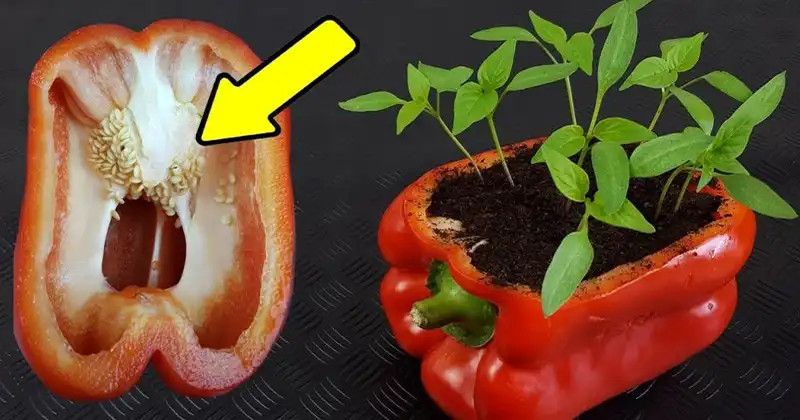Embarking on the journey of growing peppers at home is not only fulfilling but also surprisingly accessible, especially when cultivating them in pots. In this comprehensive guide, we’ll uncover the secrets to a thriving homegrown pepper harvest, from selecting the right varieties to enjoying the fruits of your labor.
- Choosing the Right Pepper Varieties: Begin by choosing pepper varieties suitable for container gardening. Options like bell peppers, chili peppers, and mini sweet peppers adapt well to confined spaces and still deliver a satisfying yield.
- Starting from Kitchen Scraps: Save seeds from a store-bought pepper to kickstart your homegrown adventure. Extract seeds from ripe peppers, rinse them thoroughly, and allow them to air-dry. These seeds are ready for planting and will likely produce peppers similar to the parent plant.
- Container Selection and Preparation: Opt for containers with good drainage and enough depth for root development. A well-draining potting mix ensures proper aeration and nutrient availability for your peppers.
- Optimal Growing Conditions: Position your pots in a sunny location, providing 6-8 hours of sunlight daily. For indoor cultivation, supplement natural light with grow lights to foster healthy growth.
- Watering and Fertilizing: Maintain consistent soil moisture, ensuring it’s not overly saturated. Employ a balanced, water-soluble fertilizer to feed your peppers, promoting robust growth.
- Pruning and Supporting Plants: Prune your pepper plants to encourage bushier growth and enhance air circulation. Staking or using cages supports the plants as they flourish with peppers, preventing breakage and simplifying the harvest.
- Pest and Disease Management: Vigilance against common pests like aphids and caterpillars is key. Natural remedies like neem oil or insecticidal soap can help, along with good garden hygiene to deter diseases.
- Harvesting Peppers: Harvest peppers when they attain the desired size and color. Use clean, sharp scissors or pruning shears to avoid damaging the plant.
- Regrowing from Seeds: To continue your pepper-growing journey, save seeds from your homegrown peppers. Extract, rinse, and air-dry them before storing for future use.
- Enjoying Your Homegrown Peppers: The culmination of your efforts lies in savoring the flavors of your homegrown peppers. From salads to stir-fries, your kitchen will come alive with the vibrant taste of freshly harvested peppers.
Secret Tips for Homegrown Pepper Success:
- Harness the Power of Complex B Vitamins: Elevate your pepper care routine by supplementing with complex B vitamins. These nutrients play a vital role in enhancing growth and promoting robust fruit development. Consider using a balanced B-complex fertilizer to provide the necessary nourishment for your pepper plants.
- Optimal Spacing for Maximum Growth: Ensure proper spacing between pepper plants to allow for optimal air circulation and sunlight exposure. This reduces the risk of diseases, promotes healthier foliage, and ultimately leads to a more abundant harvest. Refer to specific spacing recommendations for the pepper varieties you are cultivating.
- Strategic Crop Rotation: Implement a systematic crop rotation plan in your garden. Avoid planting peppers in the same location year after year to prevent soil-borne diseases and nutrient depletion. Rotate with unrelated crops to maintain soil health and optimize pepper growth.
- Companion Planting for Pest Control: Explore companion planting strategies to naturally control pests in your pepper garden. Marigolds, basil, and oregano, for example, can act as natural repellents against common pests, reducing the need for chemical interventions.
- Mulching for Moisture Retention: Apply a layer of organic mulch around your pepper plants to help retain soil moisture. Mulching also aids in weed suppression, regulates soil temperature, and provides a gradual release of nutrients, contributing to overall plant health.
- Balanced Watering Schedule: Establish a consistent watering schedule to keep the soil evenly moist. While peppers prefer slightly drier conditions between watering, ensure they receive enough water to prevent stress and promote steady growth. Use a drip irrigation system or a watering wand to target the base of the plants.
- Regular Soil Testing: Periodically test the soil in your containers for nutrient levels and pH balance. Adjust the soil composition as needed to ensure your peppers have access to the essential nutrients required for optimal growth and fruit production.
- Natural Pest Deterrents: Integrate natural pest deterrents such as garlic spray or pepper-based solutions to ward off unwanted insects. These eco-friendly alternatives minimize the impact on beneficial garden organisms while effectively protecting your pepper plants.
- Temperature Monitoring: Be mindful of temperature fluctuations, especially in container gardening. Peppers thrive in warm conditions, so monitor temperatures to prevent stress-related issues. Consider using shade cloth during excessively hot periods to shield your plants.
- Timely Harvesting Practices: Harvest peppers at their peak ripeness to encourage continuous fruit production. Regularly picking mature peppers stimulates the plant to produce more, ensuring a prolonged harvest season.
Conclusion: With these insights into successful homegrown pepper cultivation, you’re equipped to transform your space into a flourishing pepper haven. Enjoy the process, experiment with varieties, and relish the satisfaction of cultivating your own peppers from seed to table.
